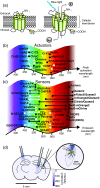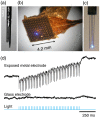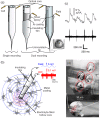Optrodes for combined optogenetics and electrophysiology in live animals
- PMID: 26158014
- PMCID: PMC4489589
- DOI: 10.1117/1.NPh.2.3.031205
Optrodes for combined optogenetics and electrophysiology in live animals
Abstract
Optical tissue properties limit visible light depth penetration in tissue. Because of this, the recent development of optogenetic tools was quickly followed by the development of light delivery devices for in vivo optogenetics applications. We summarize the efforts made in the last decade to design neural probes that combine conventional electrophysiological recordings and optical channel(s) for optogenetic activation, often referred to as optodes or optrodes. Several aspects including challenges for light delivery in living brain tissue, the combination of light delivery with electrophysiological recordings, probe designs, multimodality, wireless implantable system, and practical considerations guiding the choice of configuration depending on the questions one seeks to address are presented.
Keywords: fiber optics; genetically-encoded sensors; light-tissue interactions; neuroscience; opsins.
Figures







References
-
- Masseck O. A., Mark M. D., Herlitze S., “Use of optogenetic approaches to control intracellular signaling of G protein-coupled receptors,” in G Protein-Coupled Receptor Genetics, pp. 149–160, Humana Press, New York: (2014).
Publication types
LinkOut - more resources
Full Text Sources
Other Literature Sources

